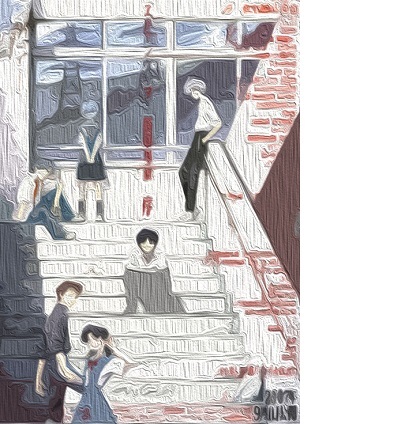January 15, 2021 18:00

"Rebuild of Evangelion: 1.0 You Can (Not) Redo", the first of the theatrical versions, was made in 2007, exactly ten years after the previous version was released in 1997. Why is it that the story is set in the 21st century, but the background is still in the 90s?
Tonight's "Friday Roadshow!" is "Rebuild of Evangelion: 1.0 You Can (Not) Redo".
Today from 9:00 p.m., "Friday Roadshow!" will be airing the first of three consecutive weeks of the "Evangelion" series, "Rebuild of Evangelion: Introduction TV Edition". Here's a review by writer Tamago Mago, who wrote about "Rebuild of Evangelion: 1.0 You Can (Not) Redo" in the past (reprinted from August 22, 2014).
Picking up the parts that retain the air of the 90s
"It's the year 2015."
This is the very first text in the first episode of Neon Genesis Evangelion, which aired in 1995; by TV standards, the third apostle will arrive next year, and the first Eva will be activated.
However, in "Rebuild of Evangelion: 1.0 You Can (Not) Redo", this text is cut, and even from the pamphlet, this text is not there. The third apostle is now the "fourth apostle," Kaworu-kun is on the moon, and the fans were in an absolute panic in 2007 when the "Rebuild of Evangelion" started to reconstruct a completely different route from the TV version and the old theatrical version. It was seven years ago, ten years after the old theatrical version. It's been that long since the first film. I've gotten used to waiting for something.
There are many major differences between the TV version and the new movie version "1.0", including the form of the Eva. The biggest difference is the character of the main character Shinji Ikari. He is not depressed. It's normal for him to be scared of riding an Eva. But he doesn't run away. Oh, Shinji is so cool. His bond with his friends is strengthened, he takes his own steps forward and grows, and he's kind of positive.
The new theatrical version of "1.0" has been reconstructed to fit the atmosphere of the 2000s. Despite creating something new and changing the direction in a chunky way, it still retains the air of 2015 that I imagined in the 90s. Let's take a look at the parts of "1.0" that retain the air of the 90s.
Public Telephone
The place where Shinji had just arrived and contacted Misato (abandoned area?) and in the emergency corridor where Hikari Horaki, Kensuke Aida, and Toji Suzuhara were, there are public telephones. The former is an orange emergency public phone (green in the TV version), and the latter is a green public phone that accepts 10 yen, 100 yen coins, and telephone cards. The green public phones still exist. The number of green public telephones, however, has decreased drastically in the past 20 years.
It depends on the area, but it's like, "Is this all there is?". It is no longer a background that can be found everywhere.
In the world of the film version, the characters have their own cell phones (Gala-phones(*1)). In "2.0", Asuka uses a cell phone in an important scene. Shinji, before he joined the NERV, even tried to contact them using a cell phone before calling a public phone, so it seems that cell phones are common in this world (in the TV version, Misato gives Shinji a cell phone after he joins the NERV). Even so, the fact that he dare to show a pay phone again and again shows the persistence of "1.0".
*1) Japanese feature phones, by contrast with newer smart phones.
Park
The park, depicted in glancing The playground equipment includes slides, jungle gyms, swings, and iron bars, and there is also a restroom. It is rare nowadays to see such a playground with playground equipment still in place. This is because playground equipment has been largely removed in some areas recently. This is one of the places that has undergone a major transformation since the 1990s.
One of the places where parks have kept their traditional form may be apartment complexes. There are many parks in the complex, complete with playground equipment, and they still function as social spaces for children and adults with children.
"1.0" is a film that specializes in depicting a city as a place where people live as a community. It is unique in that it functions as a fortress city, with buildings growing out of the ground, and the city itself is a transforming robot.
But on the other hand, if you go a bit out of the way, you can see the scenes of apartment blocks from the 80s and 90s, and the detached houses around the school are old houses with roof tiles. In "1.0" and "2.0", he dares to emphasize the mixture of the latest and the old in the city. The city as seen by the children in "1.0" and the city as seen by the adults in "2.0" can be seen in the scene where Maya goes to work. The expression of the park and school route is directly related to how Shinji sees the city, so please check it out.
Misato's style
Body conscious costume and blue sports car. Misato has the smell of the bubble economy. From the TV version to the new movie version, this style has not changed at all.
Misato's car is an Alpine Renault A310, which was produced until 1984. If you buy it now, it would cost several million yen(around $20K) or more. This is a right-hand drive version of it. It's rare because not even 10,000 units were produced in the first place. It's not that Misato is rich, but in the TV version, she was worried about the loan. I don't know how it is in the new movie version.
The image of Misato-san as body conscious is strong because of the scene in "1.0". After that, it's not so much about the costumes anymore, and in "3.0", it's about ...... oops.
Misato has a 90's bubble economy feel to her in the TV version, probably because she was the first adult woman Shinji met. This feeling is further magnified in the new movie version. In particular, the scene where Misato takes Shinji to Central Dogma and holds his hand to inspire him as his mentor, senior, and friend in arms is one of the best scenes. The scene where Shinji grabs her hand and she grabs his hand back is really good.
Misato has to be the "adult" in front of him, for Shinji all the time. By doing so, the flow to "3.0" became much stronger.
Cassette tape
The fact that Shinji is listening to a cassette tape is an important part of the film.
What he is listening to is not just a cassette tape, but an "S-DAT", a digital audio tape. The S-DAT was a promising next-generation item, but it never really caught on. It is interesting as a metaphor that it is depicted as a machine that only repeats the 25th and 26th tracks, and then moves to the 27th track in "2.0".
Nowadays, many people no longer use cassette tapes, we have moved from CDs and MDs to MP3 players, and the main media has changed from video/LDs to DVDs and then to BDs. In 2007, " 1.0" was first released on DVD, and then a digitally remastered version was released on BD, which won the battle for market share with HD-DVD at the time. Even this change in time seems to be synchronized with the change from "1.0" to "3.0" in the new movie version.
Why "1.0" emphasizes the 90s
Ritsuko Akagi's line, "These days, men are only interested in themselves," is memorable. The term "soshokukei danshi(*2)" first appeared in Maki Fukazawa's column in 2006. Considering the fact that "1.0" was released in 2007, it is interesting to see this kind of statement about men.
*2) asexual boys
Shinji Ikari, who was a representation of depression in the 90's, has come to be loved by many people in the 21st century. And the Shinji of the new movie series is portrayed as a "naïve but hard-working boy" in the eyes of adults. He is a good guy.
Hideaki Anno: "'Eva' is a story of repetition. It's a story about the protagonist going through the same trouble over and over again, and just getting back up. It is a story about the will to move forward, even if only slightly. It's a story of determination, of wanting to be with someone even if it means enduring vague loneliness and being afraid to touch others. I hope you will enjoy these four works that change from the same story to a different form."
-From the DVD booklet of Rebuild of Evangelion
In order to repeat the story, no matter how new the sense of direction we are going in, no matter how we see Shinji, we have to start from the 90s once. That's why "1.0" emphasizes the 90s.
At the same time, the viewer can't break free from the spell of Eva by being made aware of the 90s. Even though 20 years have already passed.
No matter how many times I watch "1.0", I can't escape the feeling of reading too much into the details and getting confused. I don't think I'll ever get over my "Eva habit.
(Writen by Tamago mago)
<Original JP site: https://www.excite.co.jp/news/article/E1610700408594/>
